Breeding Improved Canada Prairie Spring Red (CPSR) Cultivars

Written by: Ellen Cottee
Lead Researcher: Dr. Richard Cuthbert, AAFC-Swift Current
The wheat industry is always looking for the best: the highest yield, the strongest resistance, top quality, and the goal of strong marketability. It can be difficult to find a variety to check these boxes, but Dr. Cuthbert with Agriculture and Agri-Food Canada – Swift Current is ready to take on the challenge with his latest work in Canadian Prairie Spring Red (CPSR, or CPS Red) breeding research.
Funded in part through the Canadian Wheat Research Coalition’s 2018-2023 cluster, Cuthbert’s research is all about breeding the best CPSR wheat to give farmers a great crop and versatility to enter multiple markets.
“This is a continuation of a lot of work that has been done over the decades,” Cuthbert says about his work. “We’ve worked for many years to breed and improve high-yielding bread wheat varieties for the CPS red market class for farmers.”
The benefit of CPSR wheat is its middle-of-the-road quality, saleable to milling and export markets or feed markets, as opposed to its cousin, Canadian Western Spring wheat, and its place as a premium market product.
“Some people have said you can ride two horses with CPSR,” Cuthbert explains. “That’s really the focus of this, to push grain yield while maintaining milling characteristics.”
Also setting CPSR and CWS apart are the differences in quality parameters varieties fit into, such as limitations on trait selection and use quality. These reduced restrictions in CPSR allow wheat breeding programs to create higher performing lines with diverse genetics and traits, opening more opportunities for research and farmers alike.
“You can have stronger gluten strength, a little more room around milling yield and flower ash,” Cuthbert explained. “Some of those traits that make CWS elite, we have a little bit more room to operate on.”
Cuthbert and his team focus on breeding for high yield and strong diversity, found by using common genomic breeding practices including marker assisted selection and doubled haploidy production.
The research has been successful, with new variety HY2136 gaining registration support at the 2023 Prairie Grain Development Committee annual meeting. Yielding 19% over AC Brandon and 9% over the highest yielding CPS red variety currently available, HY2136 also checks boxes for leaf rust, stem rust, and loose smut resistance, and bears the Sm1 gene for wheat midge resistant.
HY2136 is generated through the crossing of CPS Penhold, CWS variety CDC Titanium, and an advanced line previously Cuthbert’s team created, incorporating high-yield germplasm from both Canada and Australia.
“It brought a lot of things together,” Cuthbert explained. “It’s from a cross that a lot of people would not have made if it weren’t for this type of funding that allowed for these intermediary steps and bringing diversity together.”
Other varieties from Cuthbert’s work are in the pipeline, also scoring high yield and milling quality – along with the ability to cut across different markets.
“It gives the farmer a lot of options, especially in regions where livestock is involved,” Cuthbert said. “You can bolster your feed and forage, and also fulfill milling markets if so desired.”
While the farmer benefits are important, Cuthbert also emphasizes the significance of this work for the future of wheat breeding.
“Where this work will really shine is in providing that stepping block and building parents to move diversity into the highest quality wheat in Canada. It allows that crossover of genetics to happen much more easily,” he explained. “It is going to take decades, but we have already started it.”